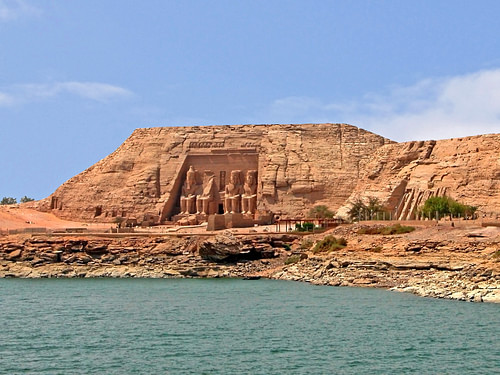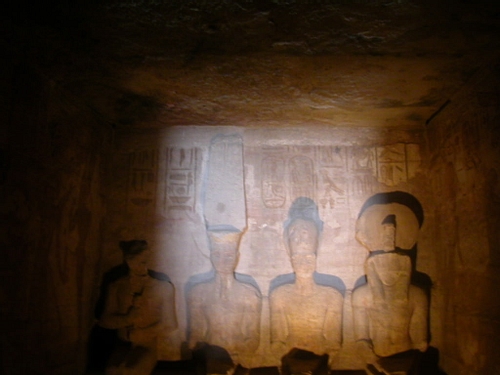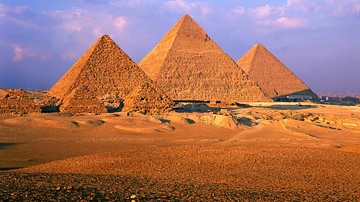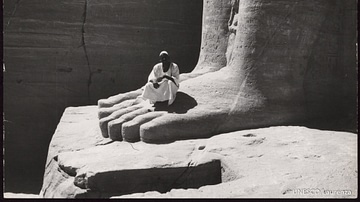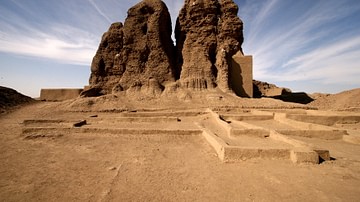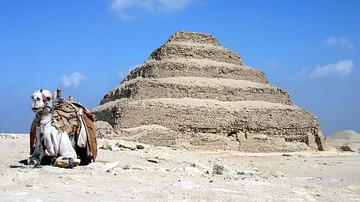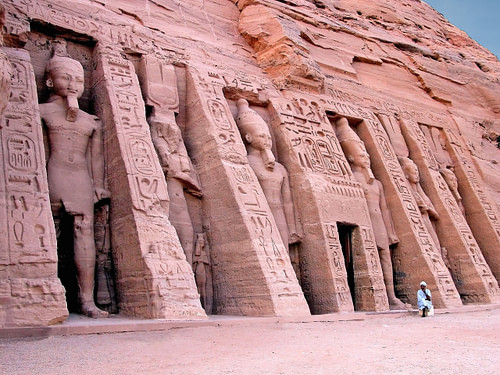
Abu Simbel is an ancient temple complex, originally cut into a solid rock cliff, in southern Egypt and located at the second cataract of the Nile River. The two temples which comprise the site were created during the reign of Ramesses II (c. 1279 - c. 1213 BCE) either between 1264 - 1244 BCE or 1244-1224 BCE. The discrepancy in the dates is due to differing interpretations of the life of Ramesses II by modern day scholars. It is certain, based upon the extensive artwork throughout the interior of the Great Temple, that the structures were created, at least in part, to celebrate Ramesses' victory over the Hittites at the Battle of Kadesh in 1274 BCE. To some scholars, this indicates a probable date of 1264 BCE for the initial construction as the victory would have been fresh in the memory of the people. However, the decision to build the grand monument at that precise location, on the border with the conquered lands of Nubia, suggests to other scholars the later date of 1244 BCE in that it would have had to have been begun after the Nubian Campaigns Ramesses II undertook with his sons and was built as a symbol of Egypt's power.
Whichever date construction began, it is agreed that it took twenty years to create the complex and that the temples are dedicated to the gods Ra-Horakty, Ptah, and the deified Ramesses II (The Great Temple) and the goddess Hathor and Queen Nefertari, Ramesses' favourite wife (The Small Temple). While it is assumed that the name, `Abu Simbel', was the designation for the complex in antiquity, this is not so. Allegedly, the Swiss explorer Burckhardt was led to the site by a boy named Abu Simbel in 1813 CE and the site was then named after him. Burckhardt, however, was unable to uncover the site, which was buried in sand up to the necks of the grand colossi and later mentioned this experience to his friend and fellow explorer Giovanni Belzoni. It was Belzoni who uncovered and first excavated (or looted) Abu Simbel in 1817 CE and it is considered likely that it was he, not Burckhardt, who was led to the site by the young boy and who named the complex after him. As with other aspects regarding Abu Simbel (such as the date it was begun), the truth of either version of the story is open to interpretation and all that is known is that the original name for the complex, if it had a specific designation, has been lost.
The Two Temples
The Great Temple stands 98 feet (30 metres) high and 115 feet (35 metres) long with four seated colossi flanking the entrance, two to each side, depicting Ramesses II on his throne; each one 65 feet (20 metres) tall. Beneath these giant figures are smaller statues (still larger than life-sized) depicting Ramesses' conquered enemies, the Nubians, Libyans, and Hittites. Further statues represent his family members and various protecting gods and symbols of power. Passing between the colossi, through the central entrance, the interior of the temple is decorated with engravings showing Ramesses and Nefertari paying homage to the gods. Ramesses' great victory at Kadesh (considered by modern scholars to be more of a draw than an Egyptian triumph) is also depicted in detail across the north wall of the Hypostyle Hall. According to the scholars Oakes and Gahlin, these engravings of the events surrounding the battle,
Present a lively account in both reliefs and text. Preparations for battle are being made in the Egyptian camp. Horses are harnessed or given their fodder while one solder has his wounds dressed. The king's tent is also depicted while another scene shows a council of war between Ramesses and his officers. Two Hittite spies are captured and beaten until they reveal the true whereabouts of Muwatalli, the Hittite king. Finally, the two sides engage in battle, the Egyptians charging in neat formation while the Hittites are in confusion, chariots crashing, horses bolting and soldiers falling into the River Orontes. In the text, Ramesses takes on the whole of the Hittite army single-handed, apart from support rendered by [the god] Amun who defends him in battle and finally hands him the victory. (208).
The Small Temple stands nearby at a height of 40 feet (12 metres) and 92 feet (28 metres) long. This temple is also adorned by colossi across the front facade, three on either side of the doorway, depicting Ramesses and his queen Nefertari (four statues of the king and two of the queen) at a height of 32 feet (10 metres). The prestige of the queen is apparent in that, usually, a female is represented on a much smaller scale than the Pharaoh while, at Abu Simbel, Nefertari is rendered the same size as Ramesses. The Small Temple is also notable in that it is the second time in ancient Egyptian history that a ruler dedicated a temple to his wife (the first time being the Pharaoh Akhenaton, 1353-1336 BCE, who dedicated a temple to his queen Nefertiti). The walls of this temple are dedicated to images of Ramesses and Nefertari making offerings to the gods and to depictions of the goddess Hathor.
A Sacred Site
The location of the site was sacred to Hathor long before the temples were built there and, it is thought, was carefully chosen by Ramesses for this very reason. In both temples, Ramesses is recognized as a god among other gods and his choice of an already sacred locale would have strengthened this impression among the people. The temples are also aligned with the east so that, twice a year, on 21 February and 21 October, the sun shines directly into the sanctuary of The Great Temple to illuminate the statues of Ramesses and Amun. The dates are thought to correspond to Ramesses' birthday and coronation. The alignment of sacred structures with the rising or setting sun, or with the position of the sun at the solstices, was common throughout the ancient world (best known at New Grange in Ireland and Maeshowe in Scotland) but the sanctuary of The Great Temple differs from these other sites in that the statue of the god Ptah, who stands among the others, is carefully positioned so that it is never illuminated at any time. As Ptah was associated with the Egyptian underworld, his image was kept in perpetual darkness.
The Aswan High Dam
In the 1960's CE, the Egyptian government planned to build the Aswan High Dam on the Nile which would have submerged both temples (and also surrounding structures such as the Temple of Philae). Between 1964 and 1968 CE, a massive undertaking was carried out in which both temples were dismantled and moved 213 feet (65 metres) up onto the plateau of the cliffs they once sat below and re-built 690 feet (210 metres) to the north-west of their original location. This initiative was spearheaded by UNESCO, with a multi-national team of archaeologists, at a cost of over 40 million US dollars. Great care was taken to orient both temples in exactly the same direction as before and a man-made mountain was erected to give the impression of the temples cut into the rock cliff. According to Oakes and Gahlin:
Before the work began, a coffer dam had to be built to protect the temples from the rapidly rising water. Then the temples were sawn into blocks, taking care that the cuts were made where they would be least conspicuous when reassembled. The interior walls and ceilings were suspended from a supporting framework of reinforced concrete. When the temples were reassembled, the joins were made good by a mortar of cement and desert sand. This was done so discreetly that today it is impossible to see where the joins were made. Both temples now stand within an artificial mountain made of rubble and rock, supported by two vast domes of reinforced concrete. (207).
All of the smaller statuary and stelae which surrounded the original site of the complex were also moved and placed in their corresponding locations to the temples. Among these are stelae depicting Ramesses defeating his enemies, various gods, and a stele depicting the marriage between Ramesses and the Hittite princess Naptera, which ratified the Treaty of Kadesh. Included among these monuments is the Stele of Asha-hebsed, the foreman who organized the workforce which built the complex. This stele also relates how Ramesses decided to build the complex as a lasting testament to his enduring glory and how he entrusted the work to Asha-hebsed. Today Abu Simbel is the most visited ancient site in Egypt after the Pyramids of Giza and even has its own airport to support the thousands of tourists who arrive at the site each year.
